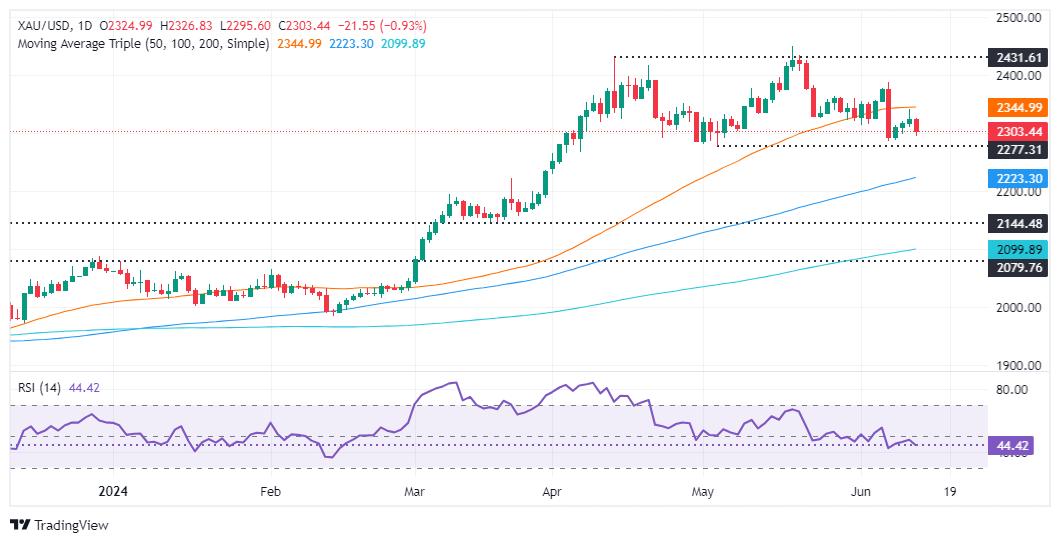Gold price slumps due to Fed’s eyeing one cut, despite soft US PPI
- Gold retreats on its way toward $2,300 after hitting a daily high of $2,326.
- Fed's revised projections show just one rate cut in 2024, a headwind for XAU/USD prices.
- Lower producer prices and higher unemployment claims boost USD, 10-year Treasury yield drops to 4.242%.
Gold prices retreated during the North American session on Thursday after hitting a daily high of $2,326. The Federal Reserve (Fed) projects just one interest rate cut instead of the three proposed since December’s 2023 Summary of Economic Projections (SEP), aka the dot plot. In the meantime, mixed US economic data boosted the Greenback to the detriment of the golden metal.
The XAU/USD spot trades at $2,303, down almost 1%. US data from the Bureau of Labor Statistics (BLS) showed lower prices paid by producers, while the number of Americans applying for unemployment benefits exceeded estimates and the previous reading.
Although the figures suggest that the Fed could set the stage to lower interest rates, Fed officials estimate just 25 basis points (bps) of easing toward the end of 2024, according to the dot plot.
Despite that, according to data from the Chicago Board of Trade, market participants are eyeing 39 basis points of easing via December’s 2024 fed funds rate contract.
The US 10-year Treasury note yield dropped seven bps from 4.310% to 4.242%, usually a tailwind for the non-yielding metal that is feeling China’s Gold buying pause.
News that the People’s Bank of China paused its 18-month bullion buying spree weighed on the precious metal. PBOC holdings held steady at 72.80 million troy ounces of Gold in May.
On Wednesday, Fed Chair Jerome Powell stated that they are less confident about inflation than previously "in order to cut." He added, "If jobs are to weaken unexpectedly, the Fed is ready to respond." When asked about the US CPI report, Powell mentioned that it is just one and emphasized the need to see the deflation process evolving toward the Fed’s goal.
Daily digest market movers: Gold price tumbles after softer US data
- US Dollar Index (DXY) increased by 0.49% to 105.20, a headwind for Gold prices.
- US Producer Price Index (PPI) in May dipped from 0.5% to -0.2%, below estimates of 0.1% expansion.
- Core PPI in May was unchanged at 0%, below forecasts of a 0.3% expansion and beneath April’s 0.5%.
- Initial Jobless Claims for the week ending June 6 rose by 242K, above the consensus of 225K and the previous week's reading of 229K.
- Despite US CPI report showing disinflation process continuing, Fed Chair Jerome Powell commented that they remain “less confident” about the progress on inflation.
- Even though the latest US CPI and PPI reports were weaker than expected, the latest NFIB Small Business Optimism Index survey for May showed that businesses are struggling with higher prices and access to cheap financing.
Technical analysis: Gold price sellers regain control as prices are headed toward $2,300
The Gold price remains neutral to downwardly biased as the Head-and-Shoulders chart pattern remains in place, hinting that the non-yielding metal price is set for further losses. Momentum as measured by the Relative Strength Index (RSI) shows that sellers are in charge, an indication that once XAU/USD’s price drops below $2,300, lower prices lie ahead.
Gold’s first support would be $2,300. Once cleared the next stop would be the May 3 low of $2,277, followed by the March 21 high of $2,222. Further losses lie beneath, as sellers would eye the Head-and-Shoulders chart pattern objective at around $2,170 to $2,160.
On the flipside, if XAU/USD soars past the June 7 cycle high of $2.387, that paves the way to test the $2,400 figure.

Gold FAQs
Gold has played a key role in human’s history as it has been widely used as a store of value and medium of exchange. Currently, apart from its shine and usage for jewelry, the precious metal is widely seen as a safe-haven asset, meaning that it is considered a good investment during turbulent times. Gold is also widely seen as a hedge against inflation and against depreciating currencies as it doesn’t rely on any specific issuer or government.
Central banks are the biggest Gold holders. In their aim to support their currencies in turbulent times, central banks tend to diversify their reserves and buy Gold to improve the perceived strength of the economy and the currency. High Gold reserves can be a source of trust for a country’s solvency. Central banks added 1,136 tonnes of Gold worth around $70 billion to their reserves in 2022, according to data from the World Gold Council. This is the highest yearly purchase since records began. Central banks from emerging economies such as China, India and Turkey are quickly increasing their Gold reserves.
Gold has an inverse correlation with the US Dollar and US Treasuries, which are both major reserve and safe-haven assets. When the Dollar depreciates, Gold tends to rise, enabling investors and central banks to diversify their assets in turbulent times. Gold is also inversely correlated with risk assets. A rally in the stock market tends to weaken Gold price, while sell-offs in riskier markets tend to favor the precious metal.
The price can move due to a wide range of factors. Geopolitical instability or fears of a deep recession can quickly make Gold price escalate due to its safe-haven status. As a yield-less asset, Gold tends to rise with lower interest rates, while higher cost of money usually weighs down on the yellow metal. Still, most moves depend on how the US Dollar (USD) behaves as the asset is priced in dollars (XAU/USD). A strong Dollar tends to keep the price of Gold controlled, whereas a weaker Dollar is likely to push Gold prices up.